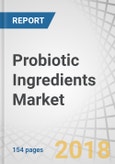The probiotic ingredients market is projected to grow at a CAGR of 8.5%.
By form, the liquid segment is projected to grow at the highest CAGR in the global probiotic ingredients market between 2018 and 2023.
Based on form, the probiotic ingredients market is segmented into dry and liquid. The liquid segment records the highest CAGR as it is relatively cheap in terms of storage and transportation. Also, the dry form utilizes methods of freeze-drying and freezing, which despite being efficient, led to higher transportation and energy consumption costs. Hence, manufacturers are focusing on experimenting with the liquid forms of probiotic ingredients for developing more equitable solutions.
By application, the pharmaceutical segment is projected to witness the fastest growth during the forecast period.
The pharmaceutical segment is estimated to grow at the highest CAGR, as probiotic strains have multiple health benefits and are gaining commercial acceptance among manufacturers, pharmaceutical & drug developers, and end consumers. Probiotic strains are proven to treat and help to prevent several gastrointestinal diseases such as traveler’s diarrhea, antibiotic-associated diarrhea, inflammatory bowel disease, lactose intolerance, irritable bowel syndrome, vaginal infections, rheumatoid arthritis, liver cirrhosis, and immune enhancement. Hence, there is a surge in demand for probiotic ingredients in the pharmaceuticals segment.
North America is projected to be the fastest-growing region in the probiotic ingredients market, due to an increase in the demand for supplements and rise in the consumption of probiotic dairy products.
The demand for probiotic-formulated food products in North America has increased, with the growing number of product launches at the consumer level. In the dairy sector, the yogurt segment is projected to account for the largest segment with consumers also recognizing fermented products containing live microorganisms. In the US, more than half of the yogurt sold is formulated with probiotics. Factors influencing probiotic yogurt consumption include the development of new flavored yogurt by manufacturers, convenient one-shot packaging, and low prices. Thus, there is a strong demand for various bacterial as well as yeast strains from probiotic product manufacturers in this region.
The global probiotic ingredients market is segmented region-wise, with a detailed analysis of each region. These regions include North America, Europe, Asia Pacific, and RoW.
Break-up of Primaries
- By Company Type: Tier 1 - 30%, Tier 2 - 55%, and Tier 3 - 15%
- By Designation: C-level - 30%, D-level - 20%, and Others* - 50%
- By Region: Asia Pacific - 55%, North America - 25%, Europe - 15%, RoW** - 5%
*Others include sales managers, marketing managers, and product managers.
**RoW includes South America and the Middle East & Africa
Leading players profiled in this report:
- Kerry (Ireland)
- DowDuPont (US)
- CHR. Hansen (Denmark)
- Biogaia (Sweden)
- Probi (Sweden)
- Glac Biotech (Taiwan)
- Bifodan (Denmark)
- Lallemand (Canada)
- UAS Laboratories (US)
- Biena (US)
Research Coverage
This report segments the probiotic ingredients market on the basis of application, source, form, end user, and region. In terms of insights, this research report focuses on various levels of analysis-competitive landscape, end-use analysis, and company profiles-which together comprise and discuss the basic views on the emerging & high-growth segments of the probiotic ingredients market, high-growth regions, countries, government initiatives, drivers, restraints, opportunities, and challenges.
Reasons to buy this report
- To get a comprehensive overview of the probiotic ingredients market
- To gain wide-ranging information about the top players in this industry, their product portfolio details, and the key strategies adopted by them
- To gain insights about the major countries/regions in which the probiotic ingredients market is flourishing
Table of Contents
Samples

LOADING...
Executive Summary
Companies Mentioned
- Biena
- Bifodan
- Biogaia
- Chr. Hansen
- Dowdupont
- GLAC Biotech
- Kerry
- Lallemand
- Probi
- Uas Laboratories
Table Information
| Report Attribute | Details |
|---|---|
| No. of Pages | 154 |
| Published | December 2018 |
| Forecast Period | 2018 - 2023 |
| Estimated Market Value ( USD | $ 268 million |
| Forecasted Market Value ( USD | $ 402 million |
| Compound Annual Growth Rate | 8.4% |
| Regions Covered | Global |
| No. of Companies Mentioned | 10 |









